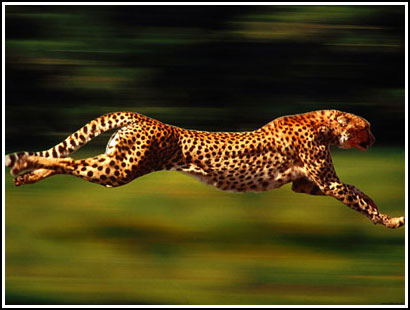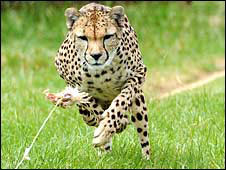Study the mystery of the speed of the
With runways, camcorders and a piece of chicken, scientists are trying to discover the mystery of the speed of cheetahs.
A research team from the Royal Veterinary University (RVC, London, UK) is using a high-speed camera and a sensitive track to monitor the 'big cat' when he is sprinting.
Leopard species can reach speeds of at least 104km / h and can reach maximum speed within just a few jumps. This research is being done on the North African leopard at the ZSL Whipsnade zoo.
GS. Alan Wilson, director of the Structure and Movement Laboratory at RVC said: ' The leopard is charming. They can run faster than any animal we know about 50%. So in order to understand what made the speed limit, newspaper is a great animal to study '.

The remarkable speed of the leopard
Research methods - Chasing chickens
Like domestic cats that can't resist chasing a piece of a rope, cheetahs also find the appeal of a rope being pulled away. It is difficult to deny such a string, especially when there is a bait dangling at the end of the string.
So the team " seduced " the zoo's alerts by attaching a piece of chicken to a fast-moving rope that was pushed along the fence with an electric motor.

The note is chasing the chicken
(Photo: BBC)
When the cat chases the chicken bait, four high-speed cameras are capable of " blinking " 1,000 frames per second - far more than the 25 frames per second of a normal standard camera - capturing every movement of animals.
Penny Hudson, a doctor at the Royal Veterinary University, said: ' We use two cameras on each side of the fence to be able to observe the leopard from both sides. When a leopard gallops, there will be differences between each side of the body - it has an asymmetrical movement '.
Scientists also use special metal plates placed on the runway of the leopard.
" These sheets of metal are like a sophisticated disk scale that can measure the force on the legs of the leopards, " explains Hudson.
Animals run like lightning
Scientists will compare the results of leopard studies with other studies conducted on rabbit dogs, an animal that can reach speeds of approximately 60km / h.

Rabbit hound on the track
(Photo: BBC)
Hudson said: 'Rabbits are domesticated to run faster while leopards train themselves. But cheetahs can run a lot faster than a rabbit hound trained to participate in racing '.
Compared to cheetahs, the speed of humans is too modest. The fastest runner is Usain Bolt - running 100m losing 9.69s (averaging about 37km / h).
Scientists also compare the causes of the speed of each species.
For rabbits, speed is limited by the movement of two legs. But for cheetahs, the cause has not been elucidated - because the results obtained from the experiment will have to be analyzed to test the strength and motivation of the leopard legs, the speed and the length of each stride as well as aperture and posture of joints.
Ms. Hudson added: ' We really don't know what makes these newspapers so fast - maybe because of their flexible backbone or maybe because of the shoulder bones, which can help them to open. Wide legs a little more. Hopefully the data collected can help us unravel these mysteries . "
Wild leopards run faster?

Usain Bolt is running on the 100m track (Photo: BBC)
In 1997, in a journal of the Journal of Zoology, the data on the maximum speed of the leopard species was 104km / h. The figure was taken from an experiment in Kenya in 1965, where captive leopards were timed when it chased after the remainder of the lunch after a car.
But researchers think it is very likely that this cat can run faster than that.
GS. Wilson, who has a bioengineering study funded by the Biotechnology and Biological Sciences Research Council, said that the jaws confined in Whipsnade could reach speeds of 54km. /hour. He explained: ' We know cheetahs will not reach their optimal speed in captivity .'
So he wants his research team to be able to conduct studies with leopards in the natural environment, where they can see how the newspapers run and try to record more accurately. optimal speed of this leopard.
GS. Wilson said his team also hoped to attach the global positioning system to the leopards and get an image of the wild leopard's activities because of the wild environment where the panther is shown. at the end of its speed, from there learn the ' secret ' of the speed of this animal.
- The first time slow down the speed of light
- First determine the rotation speed of the black hole
- US will speed test the speed of 1,100km / h
- Decipher the mystery of the dinosaur's blood
- Korea develops 'fast as lightning speed train'
- 10 mysteries make scientists lose
- The weirdest shark in the world
- 7 mistakes when using the high speed can cause the electric drive to explode, causing harm to the whole family
- The mystery of the rise of the Himalayas
- Japan tests super-speed train running on the magnetic buffer
- Things you don't know about the speed of light
- The catastrophic outcome of cars drove through 100 speed bumps at speeds of 160km / h
 Animal 'suffering' after hibernation
Animal 'suffering' after hibernation Why do goats climb well?
Why do goats climb well? Scientists were surprised to see chimpanzees eating turtles
Scientists were surprised to see chimpanzees eating turtles Giant catfish died deadly due to drought in Thailand
Giant catfish died deadly due to drought in Thailand